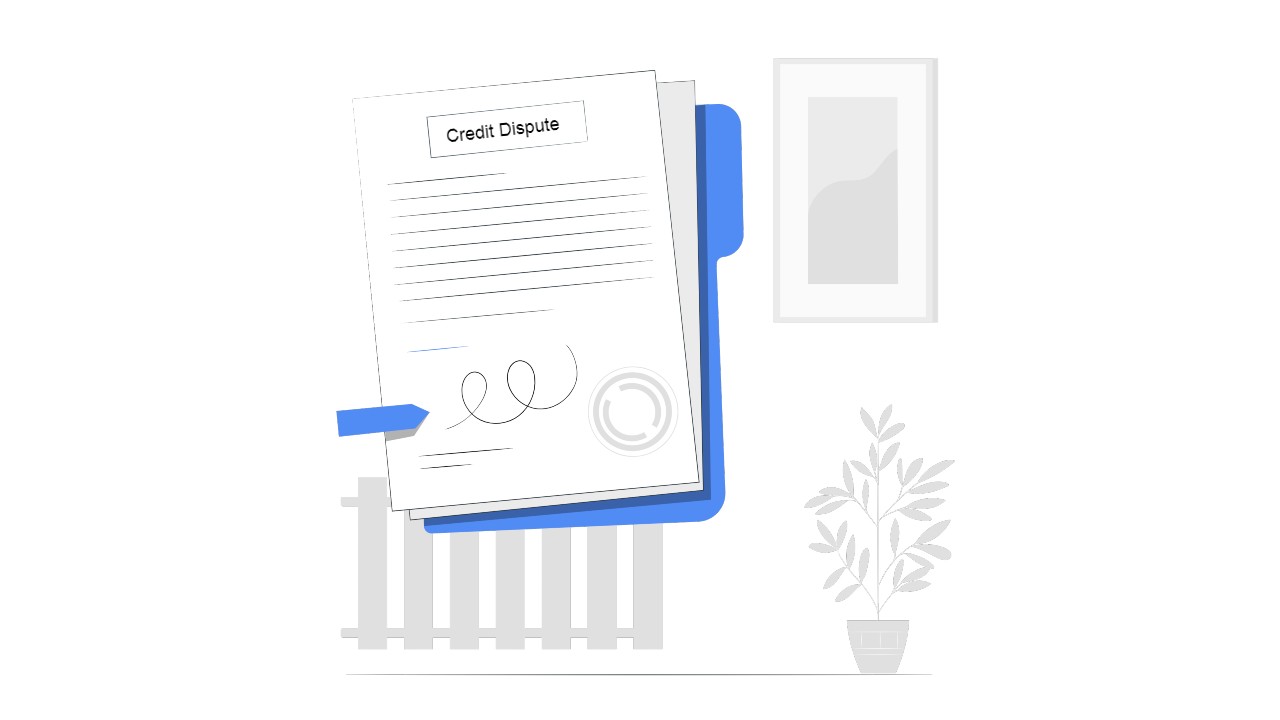
How to Write the Best Credit Dispute Letter to Fix Errors?
People generally prefer not to encounter adverse details in their credit reports. While it’s impossible to erase negative entries like late payments or collection accounts solely due to their negative nature, you can file a dispute to prompt the credit reporting agency to examine the disputed information. If your credit report contains inaccuracies or omissions- you can write a credit dispute letter to request bureaus to correct them!

This dispute goes to the entity responsible for the information, typically the company managing the account. Should the lender find the reported account details need corrections, it will rectify the information by updating or removing the account.
However, it is essential to have a detailed credit dispute letter to inform the bureau of the discrepancies and have it make modifications. We discuss more about it below.
What Is a Credit Dispute Letter?
Sending a letter to a credit reporting agency (such as Experian, TransUnion, or Equifax) to inform them of your belief that certain information in your credit report is inaccurate is commonly known as a “credit dispute letter”.
Within this letter, you will enumerate any items you believe are inaccurate, providing explicit details on what is incorrect and how you propose the item should be accurately reported. Disputing information on your Experian credit report may take up to 30 days to conclude. The bureau initiates the investigation process only upon receiving the letter.
The Fair Credit Reporting Act (FCRA) is a federal law governing how credit reporting agencies manage consumer information. It establishes your entitlement to challenge data within your credit file.
You possess the right to obtain your credit report without charge from each credit bureau (available at AnnualCreditReport.com) under the FCRA. It allows you to contest any information you deem inaccurate or incomplete.
When disputing information on your credit report, the bureau typically reaches out to the information provider. It is often a lender or business seeking confirmation of the accuracy of the reported account. If the lender identifies any discrepancies requiring correction, it will update or remove the account accordingly.
If you have been exploring online, you might have encountered the term “609 dispute letter” as a tool for enhancing your credit. What does this term signify when curating credit letters? It points to section 609 of the FCRA, which grants you the right to request copies of your credit reports. (Technically, section 611 acknowledges your right to dispute information, but it is a bit beside the point.)
While you can purchase a 609 letter of dispute template online, there’s little value in doing so. Disputing information on your credit report is a free process when you directly engage with the credit reporting agencies and don’t require any specific template for the task.
 Also Read: Non Profit Fundraising Letters
Also Read: Non Profit Fundraising LettersWhich Errors Can You Dispute on the Credit Report?
Credit repair companies offering 609 letters may also propose you can “repair” your credit by eliminating negative items. While disputing inaccurate information or addressing identity theft concerns is legitimate, it’s improbable that the bureau will erase accurate details from your credit report, regardless of the letter format.
Below are instances you might rectify through a sample letter of credit dispute:
- Someone opened an account for identity theft, and it is not legitimately yours.
- An address linked to your profile displays an incorrect house number.
- Your credit report indicates a bankruptcy, though you have never filed for one.
- Despite having evidence of timely payment, your credit card company reported a late payment.
Most adverse information, like late payments, typically persists on your credit report for up to seven years.
(Note: Variations in identification details, like name and address, do not influence your credit scores.)
Businesses and individuals must regularly review their credit reports and consider many things. However, they must search tradeline disputes because they are among the most significant factors.
Tradelines are your credit history, account information, and other crucial details. Other accuracy disputes include details consumers might think are inaccurate or falsely quoted. People or organizations can only report errors and use the credit dispute letter template when aware of the discrepancies.
You can use a credit dispute letter if you see these elements:
Incorrect account status details: Your credit report might show a late payment or due bill even though you paid on time. It might also state that you only completed a part payment, which is inaccurate data.
Incorrect account number: The number of one or more of your accounts having missing characters needs a correction. It can have a diverse effect on your report, making writing credit letters essential. Incorrect credit limits or balances on current accounts can be crucial to rectify. It is significant to manage your overall credit utilization, particularly in cases where your credit limit is higher- or you have recently settled a loan or another outstanding balance.
You have still listed an ex-spouse on the credit card or loan account: People must close a crucial chapter by removing their ex-spouses from their financial accounts. It prevents them from being accountable for someone else’s buying behavior or habit. Also, it might negatively affect their credit score.
Using a credit dispute letter template to report errors is significant because they might indicate identity theft or other crimes. For example, you might notice addresses you have never lived at or view details about bank accounts you never opened.
What Errors Can't You Dispute on Credit Reports?
In simple terms, if you were late on a payment because you forgot to send the check before your vacation, and it’s true, you can’t argue about it because it’s accurate. However, telling your lender if something unexpected comes up and you might miss a payment is always advisable. If your lender has agreed to remove the late pay and give you a letter, you can show that letter when you dispute the information to get it fixed.
What Information to Include in a Credit Dispute Letter?
Credit bureaus make it simple to dispute information, primarily by sending credit dispute letters in the post.
You can use a dispute form or write a letter outlining your concerns. Your dispute letter should contain the following information:
Your complete name
Your birth date
Your Social Security number
Your current address and any other residences from the last two years
A photocopy of a government-issued identification like a driver’s license or state ID
A photocopy of a utility bill, bank statement, or insurance statement
You can print and fill out a dispute form, attaching it to your credit letters. Alternatively, you can list every item on your credit report you think is incorrect, including the account number and why you believe in the inaccuracies. Be clear and provide factual details. If you have supporting documents, like a police report for an identity theft incident, include copies with your letter.
You can ship your credit dispute letter template with the documentation and filled-out forms to this address.
Experian
You can also scan the forms to submit electronically to Experian’s official website at experian.com/upload.
Experian
P.O. Box 4500
Allen TX 75013
Equifax
Firms and individuals can follow the same process to dispute items on their Equifax reports. They can send your letter of dispute with a completed form to this address.
Equifax
P.O. Box 740241
Atlanta GA 30374
TransUnion
As discussed above, sending credit dispute letters to every agency stays the same. Mail the letter with a copy of the completed TransUnion dispute form at this address.
TransUnion Consumer Solutions
P.O. Box 2000
Chester PA 19022
How Long Does a Bureau Take to Resolve Your Disputed Items?
All three credit bureaus take 30 days to investigate the dispute case and nearly five working days to update you about their findings. They also sometimes take over 45 days for the investigation (depending on the error’s complexity.) It applies to all disputes, including the ones you make over the phone or online.
Senders must add a few days more if they want to send credit dispute letters via the mail. They can choose a Canada Post mailing service like registered mail based on their speed preference and drop the envelope at the Post Office or in a nearby mailbox. The credit bureaus also send their replies in the post once they complete the investigation.
Other Methods to Dispute Credit Report Errors
Experian’s Dispute Center walks you through the steps online and sends you email updates so you can follow what’s happening. When you do it online with Experian, they usually sort it out within 30 days.
You can also dispute by phone. Dial the number on your Experian credit report to begin the process. If you want your Experian credit report sent by mail, call 888-EXPERIAN.
When incorrect info is on your credit report, the company that reported it must fix it with each credit bureau they told. To ensure, keep an eye on your reports from all three bureaus and send a template credit dispute letter with each, if necessary.
Does Using the Dispute Letter Template and Following a Dispute Process Affect Your Credit Score?
Just filing a dispute doesn’t impact your credit score, but the result of the dispute can. For instance, if you can prove that a delinquent account on your credit report is due to identity theft and not yours, they’ll remove the account (and any late payments, collections, or defaults linked to it), probably boosting your credit score.
Disputing stuff on your credit report probably won’t reduce your credit score, even if things don’t go your way. Because the inaccurate info you disputed was already there, keeping it there usually doesn’t affect your score anymore.
However, please don’t hesitate to write and send a credit report dispute letter when you are sure of the mistake.
Keep All Your Documents Handy
What if you have argued about things on your report, and they say it’s right and won’t remove it? Negative stuff only sticks around on your credit report for a while, then it drops off, and your credit score improves. You can also add a short note explaining things, like if a late payment happened because you lost your job or got sick. Even though it doesn’t change your score, it might help lenders understand your story.
Even though Experian usually finishes things faster, they give it 30 days by law. The time it takes depends on what you are disputing and how fast the lender or whoever provided the data reacts. To keep your credit report and score good, check your free report and score regularly.
It gives you time to fix things you don’t agree with before applying for a student loan or credit. Also, it helps you catch and dispute possible fraud early.
Sample Credit Dispute Letter Template to Send to Equifax, Experian, or TransUnion
Follow this sample of credit dispute letters.
[Date]
[Your Full Name]
[Your Mailing Address][Your City, State, and ZIP Code]
[Bureau Name]
[Street or Delivery Address][City, State, and ZIP Code]
Subject: Disputing Incorrect Items in Credit Report
I am writing this credit dispute letter to dispute the following details you supplied to [credit bureau name]. Its report has inaccurate information. I have marked the items I wish to dispute on the attached credit report copy.
This detail [for example, the account number and the company name Star Inc.] is incomplete and inaccurate because [explain in-depth how it is invalid or incomplete with adequate resons]. I request that [trading name] remove or change the item to correct the data.
[Add list and description of other disputed items, if that applies.]
I’m sharing copies of the latest credit report with the documents here. [Add a valid description, for example, your bank statement showing you have paid off some bills the bureau has marked unpaid]. Please reinvestigate this case and connect with the credit bureaus to ask them to delete or modify the disputed item(s) at the earliest.
Sincerely,
[Your full name]
Enclosures: [The document types and serial numbers]
Can It Not Be Worth It to Dispute an Item?
Header errors are those mistakes that might not be worth disputing. They have very little impact on your credit score, making them almost irrelevant. Some examples include an old employer, a misspelled name, or some other detail that doesn’t affect your financial reports.
You can skip writing a credit report dispute letter for these errors, but you need to send it for other reasons.
After all, it is in your hands to improve your credit score. The bureau might overstate or understate many things, so you should be aware of the errors.
Try enclosing the report copy where you highlight the disputed item/s. You can use Certified Mail with the return receipt to mail your letters, ensuring the business acknowledges receiving them! Retain the original copies, duplicate records, and all supporting documents.
Senders can use the example of a credit dispute letter to challenge inaccurate report details that the bureaus provide. The content should mention every disputed item and state the facts. Also, it must clarify the reason for disputing it with a request for the institute to make the necessary corrections or removals.
How to Dispute Invalid Debts
Debt collectors utilize various information sources in their efforts to collect debts. To effectively challenge their claim(s), consumers need to approach the process with methodical and thorough preparation.
Firstly, firms must gather all relevant information and evidence concerning the debt. It includes any correspondence or documentation they receive from the creditor and evidence demonstrating that the debt is invalid. Also, they must collect testimonies from witnesses who can attest to the fact that you do not owe any debt to the said party.
You are in luck because keeping a record of these details is possible. Firstly, businesses must obtain the collector’s information, including their name, address, and phone number; collectors who refuse to provide this information may be potential scammers. Also, mentioning these details in your credit dispute letter can make it more authentic.
Within the first phone call or five days, you must receive details about the alleged debt, such as the amount, the current debt owner, and information to contact the original creditor. Please note this information if you don’t get the data within the stipulated timeframe.
Immediately request a copy of your credit report from the three major reporting agencies (Experian, Equifax, and TransUnion). According to the Fair Credit Reporting Act (FCRA), credit agencies must provide information about your file and credit score. You can send the credit report dispute letter whenever necessary.
Thoroughly review each credit report to identify errors. Complete a credit bureau dispute form and print your credit report, highlighting the mistakes. Submit your dispute to the credit agency by uploading it or sending it via certified mail with the return receipt.
Following these steps will initiate the process of rectifying the inaccurate claim against you, but more must be done.
Debt Dispute Letter
If you question the validity of a debt or believe that the owed amount is incorrect, the recommended course of action is to send a debt dispute letter to the collection agency.
A good debt or credit dispute letter argues that debt should be simple and cover all the crucial info about the money you owe.
When you send a letter saying you disagree with a debt, the company trying to get the money has to prove that you owe it. They must give many details and papers to show how much you owe.
By law, if you get a letter saying you owe money, you have a month to send a letter, saying you don’t think it’s right. The 2021 rules from the Consumer Finance Protection Bureau made it easier because now all the companies have to give you a special form that you can use to argue about the debt instead of writing a big letter.
The tear-off form is part of a letter debt collectors have to send you. It has:
– The debt collector’s name and address
– The original creditor’s name
– How much money you owe (including interest, payments, credits)
– The debt amount when they send the letter
– Information about your rights, like how to challenge the debt
– Any account number linked to the debt
The collector thinks the debt is valid if you don’t argue about the debt within 30 days. However, they have to only contact you once they confirm the debt if you dispute the same!
If you choose to write a letter of dispute instead of using the tear-off form, your letter should include your details, how much money you owe, and the creditor’s name. Request them not to report the debt to credit agencies until they fix the problem. You may ask them to remove it if it’s already on your credit report.
After you send a dispute letter to the credit reporting agencies about the debt, it’s a good idea to send them another letter with the same info to make sure they know you’re still disputing it.
Sometimes, the problem doesn’t get fixed until the wrong info is already on your credit report, and that can make your credit score worse. If that happens, you should send another letter to the credit reporting agency. In this letter of credit dispute, say that the information is not right and ask them to fix it or take it off. You can also do this dispute online when you check your credit report.
Pros and Cons of Sending Credit Letters by Mail
Similar to any dispute method, disputing an error in your credit report by mail has both advantages and disadvantages, including
Pros of disputing via mail
The ability to enclose documents with your credit dispute letter is advantageous. In contrast, disputing over the phone would necessitate mailing in documents for evidence afterward. With a letter, you can submit both the claim and supporting evidence in a single mail package.
Drafting a letter offers ample space to elaborate on your dispute, allowing you to ensure clarity and thoroughness through the editing process.
Cons of disputing via mail
When sending a credit dispute letter, you’ll be mailing personal documents to a P.O. Box. Opting for certified mail and obtaining a receipt can offer a degree of protection and reassurance.
Sending a letter may extend your timeline by a few days. Unlike an online dispute, which is received instantly, the postal service will take a bit more time to deliver your letter to the credit bureau.
How Can PostGrid’s Direct Mail API Help You Send Credit Letters?
Our direct mail API allows you to design, print, and ship the letter of credit dispute to agencies and other recipients. Businesses can sign up for a free account promptly to check out our features. They must only pay for the items they send!
PostGrid offers many built-in letter templates, allowing you to customize messages, graphics, and other elements. You can use our template editor to modify anything you want and curate designs that fit your branding styles.
Also, we help you print and ship high-quality letters to credit agencies like Experia and others. You can retain and access the copies via your dashboard whenever needed. However, we offer more to help you achieve your mailing goals with PostGrid.
Personalization Via Variable Data Printing
PostGrid lets you send personalized credit dispute letters to intended recipients. They allow you to change your messages for every receiver, helping you effectively convey your points!
We use variable data printing to let you print personalized letters in a single run, saving time and expenses. Also, you can add or remove the variable data based on your needs and preferences without hassles.
Business Reply Mail (BRM)
The Business Reply Mail (BRM) feature allows you to send a return envelope with your credit letters, encouraging the recipients to write back. It facilitates faster responses because the receiving agency can immediately draft a reply, insert it into the pre-paid mailer, and drop it in the mailbox.
The process is simple and upfront. We allow you to design and send the BRM cards or envelopes the same way as your letters, speeding up and simplifying the process.
Response Mechanism
You can include QR codes and pURLs within your template credit dispute letter to induce the reader’s responses. It is another method to get recipients to respond to the messages without delays.
Including these response mechanisms within the credit report dispute letter enables recipients to reply whether they can correct the error or need you to complete additional procedures. Sign up now for more details on how to use the credit dispute letter template with PostGrid!
| You may also want to read | |
|
1. |
Medical Necessity Letter Sample |
|
2. |
Marketing Ideas for Loan Companies |
|
3. |
How to Use C O In Mailing Address |
|
4. |
Automotive Marketing Strategies |
|
5. |
Volunteer Appreciation Ideas |
|
6. |
Interactive Direct Mail Ideas Examples |
Ready to Get Started?
Start transforming and automating your offline communications with PostGrid









